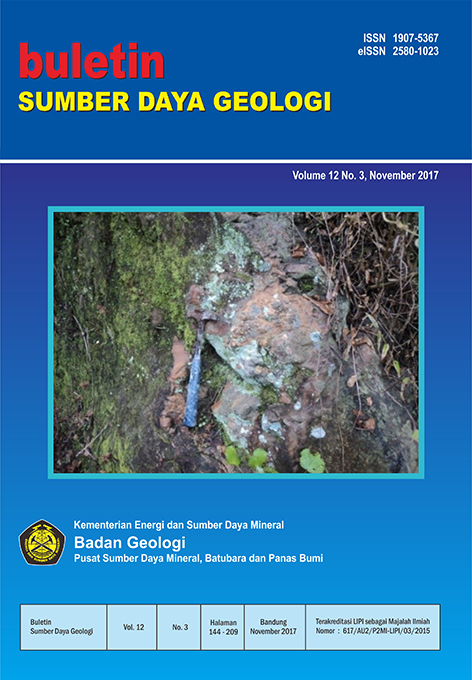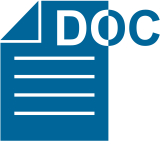EVALUASI POTENSI BATUBARA UNTUK UNDERGROUND COAL GASIFICATION PADA LUBANG BOR JWT-02, DAERAH AMPAH, KABUPATEN BARITO TIMUR, PROVINSI KALIMANTAN TENGAH
Abstract
Potensi batubara Indonesia, baik yang dapat ditambang secara terbuka maupun yang ada di bawah permukaan (kedalaman >100m), sebagian besar merupakan batubara peringkat rendah. Salah satu pemanfaatan batubara peringkat rendah adalah gasifikasi bawah permukaan. Data dan evaluasi awal tentang potensi batubara untuk kegiatan gasifikasi ini sangat diperlukan. Evaluasi potensi batubara untuk gasifikasi ini pada Lubang Bor JWT-02 telah dilakukan dengan parameter evaluasi antara lain, kedudukan/kedalaman batubara, ketebalan batubara, karakteristik batubara, batuan pengapitnya dan sumber daya batubara. Hasil evaluasi tersebut menunjukkan adanya potensi lapisan batubara yang dapat dikembangkan untuk gasifikasi bawah permukaan.
Downloads
References
Anonim, 2016. Executive Summary Pemutakhiran Data Dan Neraca Sumber Daya Energi Tahun 2016, Pusat Sumber Daya Mineral Batubara dan Panas Bumi, Bandung.
Burton, E., Friedmann, J. and Upadhye, R., 2006. Best Practices in Underground Coal Gasification, Lawrence Livermore National Laboratory, Livermore, CA.
Couch, G., 2009. Underground coal gasification, IEA Clean Coal Centre, International Energy Agency, London.
GastTech, 2007. Viability of Underground Coal Gasification in the ‘Deep Coals’ of the Powder River Basin, Prepared for the Wyoming Business Council Business and Industry Division State Energy Office, Casper, WY.
Imran, M., Bohar, M., Burdi, Ameer., Qayyum, A., Bhatti, M., Shabbir, M., 2012. Underground Coal Gasification and Power Generation, The Operational Aspects, 45th IEP Convention 2012.
Madiutomo, N., 2014. Potensi Resiko Lingkungan Teknologi Gasifikasi Batubara Bawah Tanah (Underground Coal Gasification - UCG) , Majalah Mineral & Energi, h. 49-59.
Purnama, A. B., Subarna, Y,S., Sendjadja, Y,A., Muljana, B. dan Santoso, B., 2017. Potensi Batubara Untuk Pengembangan Gasifikasi Bawah Permukaan: Studi Kasus Desa Macang Sakti, Provinsi Sumatera Selatan, Jurnal Teknologi Mineral dan Batubara, 13(September 2016), pp. 13–30.
Purnomo, Wawang S. dan Dwitama, E. P, 2016. Pengeboran Dalam Untuk Evaluasi CBM Dan Batubara Bawah Permukaan Di Daerah Ampah Kabupaten Barito Timur Provinsi Kalimantan Tengah, Pusat Sumber Daya Mineral Batubara dan Panas Bumi, Bandung.
Shafirovich, E. ., Mastalerz, M., Rupp, J., dan Varma, A., 2008. The Potential for Underground Coal Gasification in Indiana, Phase I Report to the Indiana Center for Coal Technology Research (CCTR), Indiana.
Shafirovich, E. and Varma, A., 2009 Underground Coal Gasification: A Brief Review of Current Status, School of Chemical Engineering, Purdue University, 480 Stadium Mall DriVe, West Lafayette, Indiana 47907.
Soetrisno, Supriatna, S., Rustandi, E., Sanyoto, P., dan Hasan, K., 1994. Peta geologi lembar Buntok, Kalimantan. Pusat Penelitian dan Pengembangan Geologi, Bandung.
Sury, M. White, M., Kirton, J., Carr, P., Woodbridge, R., Mostade, M., Chappell, R., Hartwell, D., Hunt, D., and Rendell N., 2004, Review of Environmental Issues of Underground Coal Gasification, Report No. COAL R272, DTI/Pub URN 04/1880, DTI, UK.
Zieleniewski, M. and Brent, A. C., 2008. Evaluating the costs and achievable benefits of extending technologies for uneconomical coal resources in South Africa: the case of underground coal gasification, Journal of Energy in Southern Africa, 19(4), pp. 21–31.
Copyright (c) 2017 Buletin Sumber Daya Geologi

This work is licensed under a Creative Commons Attribution-NonCommercial-ShareAlike 4.0 International License.
Authors whose manuscripts are published agree to the following terms:
The publication rights of all journal manuscript materials published on the Buletin Sumber Daya Geologi website are held by the editorial board with the knowledge of the author (moral rights remain with the manuscript’s author).
The formal legal provisions for access to digital articles in this electronic journal are subject to the terms of the Creative Commons Attribution-ShareAlike (CC BY-SA) license. This means that Buletin Sumber Daya Geologi has the right to store, convert media/formats, manage in the form of a database, maintain, and publish the article without requesting permission from the author, as long as the author’s name is cited as the copyright holder.
Manuscripts published in both print and electronic formats are open access for educational, research, investigative, and library purposes. Beyond these purposes, the editorial board is not responsible for any violations of copyright law.















